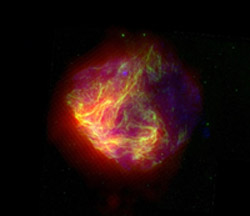Multi-wavelength images help astronomers study star birth, death

This false-color image shows infrared (red), optical (green), and X-ray (blue) views of the N49 supernova remnant. This object, the remains of an exploded star, has million-degree gas in the center, with much cooler gas at the outer parts of the remnant. Credit: NASA (SSC/HST/CXC), U.Illinois (R.Williams & Y.-H.Chu)
Black and white reproductions of Vincent van Gogh’s “The Starry Night” lack the beauty and depth of the original oil painting. In a similar fashion, images of stars and galaxies composed of a single wavelength band cannot convey the wealth of information now accessible to astronomers.
In recent years, a number of ground-based optical and radio surveys of the Large and Small Magellanic Clouds — Earth’s nearest neighboring galaxies — have become available. New composite images of optical, radio, infrared, ultraviolet and X-ray wavelengths are giving astronomers at the University of Illinois at Urbana-Champaign a clearer picture of the birth, life and death of massive stars, and their effect on the gas and dust of the interstellar medium surrounding them.
From their birth to their death, massive stars have a tremendous impact on their galactic surroundings. While alive, these stars energize and enrich the interstellar medium with their strong ultraviolet radiation and their fast stellar winds. As they die, shock waves from their death throes inject vast quantities of mechanical energy into the interstellar medium and can lead to the formation of future stars.
“Comparing images at different wavelengths lets us create a more complete picture, rather than seeing only a few features in isolation,” said You-Hua Chu, chair of the astronomy department at Illinois. “Using multi-spectral data sets, we can examine the physical structure of the interstellar medium and study the conditions that lead to star formation.”
Massive stars interact with the interstellar medium in many ways. Their fast stellar winds and supernova blasts can sweep up the surrounding medium into expanding shells filled with hot gas.
“The expanding shells produce conditions that may start a new wave of star births,” said Robert Gruendl, an Illinois astronomer who uses Spitzer Space Telescope observations to search for proto-stars. “The combination of X-ray, optical and infrared observations allow us to determine whether the pressure of the hot gas or compression by a passing shock wave is responsible for triggering star formation.”
In related work, Illinois astronomer Rosa Williams has added data from a new wavelength regime to her growing database on stellar graveyards in the Magellanic Clouds. Comparing infrared images obtained with the Spitzer Space Telescope, Williams explored the distribution of matter caught in the expanding shells of supernova remnants.
“We expected significant infrared emission to be generated by dust particles,” Williams said. “Instead, most of the emission from these remnants came from heated gas.”
Strong ultraviolet radiation from nearby star-forming regions may have ionized the gas and torn apart the dust particles consisting of hydrocarbon molecules, Williams said. “Other dust particles could have been shattered by shock waves from the supernova.”
To solve the missing dust mystery, Williams said, “We are investigating the nature and amount of dust in regions surrounding the supernova remnants to see whether the deficiency in dust is inherent in the environment or created by the remnant.”
Chu, Gruendl and Williams will present their latest findings at the American Astronomical Society meeting in Washington, D.C., on Wednesday (Jan. 11).
Media Contact
More Information:
http://www.uiuc.eduAll latest news from the category: Physics and Astronomy
This area deals with the fundamental laws and building blocks of nature and how they interact, the properties and the behavior of matter, and research into space and time and their structures.
innovations-report provides in-depth reports and articles on subjects such as astrophysics, laser technologies, nuclear, quantum, particle and solid-state physics, nanotechnologies, planetary research and findings (Mars, Venus) and developments related to the Hubble Telescope.
Newest articles

Properties of new materials for microchips
… can now be measured well. Reseachers of Delft University of Technology demonstrated measuring performance properties of ultrathin silicon membranes. Making ever smaller and more powerful chips requires new ultrathin…

Floating solar’s potential
… to support sustainable development by addressing climate, water, and energy goals holistically. A new study published this week in Nature Energy raises the potential for floating solar photovoltaics (FPV)…

Skyrmions move at record speeds
… a step towards the computing of the future. An international research team led by scientists from the CNRS1 has discovered that the magnetic nanobubbles2 known as skyrmions can be…





















